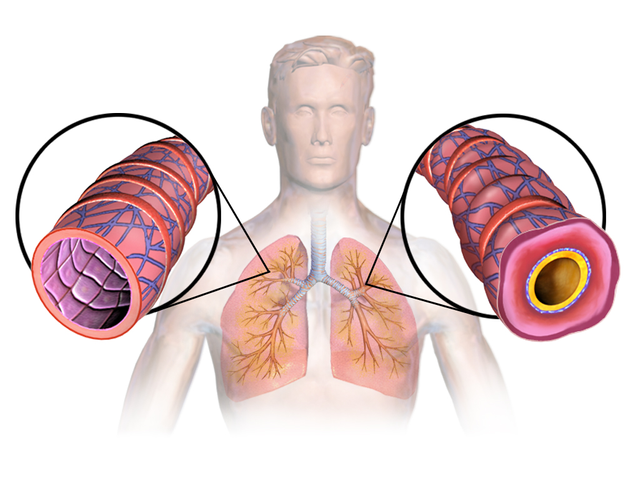Pulmonary Medicine # 02, ASTHMA-LET US TALK.
Hello friends, hope you are all fine
This is my second post on the pulmonary medicine and this post is about ASTHMA. Diseases of lung are one of the most common diseases in the world in which asthma alone affects about more than 300 million people. So let us discuss asthma.
What is asthma?

Wikimedia-licensed under the Creative Commons Attribution-Share Alike 4.0
Asthma is a chronic inflammatory disease of airways characterized by increased responsiveness of airways to variety of stimuli. One point to be noted here is that increased responsiveness is genetically determined , so a trigger (or allergen) of asthmatic attack to one individual may be absolutely normal to other.
Wikimedia CC SA 3.0 Asthma attack
What are the causative factors?
Two major factors in causation of asthma are Environment and Genetics.
Wikimedia License-Creative Commons Attribution-Share Alike 3.0
Let me first briefly put forth some scientifically proven points in favor of genetics
- Twin study has shown about 25% increase in risk of asthma in an identical twin, If one is affected.
- Family history has positive association with asthma.
- So far more than 100 genes ( like GSTM1, CTLA-4, SPINK5, ADAM33 etc) have been linked to asthma.
Environmental triggers include both indoor and outdoor pollutants, certain viral infections, drugs like aspirin and beta blockers, cold air , exercise, emotions and stress etc.
Route of exposure to trigger may be
- Respiratory route (house dust, pollen, cold air, animal dander, feathers etc ).
- Ingestion (allergen in fish , milk , meat , yeast etc).
To make this concept clearer, you can imagine a situation in which you are playing a game or eating food with a predisposed individual and unfortunately both of you came in contact with an allergen, you may still continue to eat or play but predisposed person may have to stop as he may experience an asthmatic attack and may need immediate medical care.
Gut microbial dysbiosis during early 100 days of life has been associated with development of childhood asthama. It may be due to change in metabolites like short chain fatty acids due to change in gut microbes
Manifestations of Asthma.
An asthma patient may present with one or more of the following symptoms-
Dyspnea or Breathlessness - When you ask patient, what problems are you facing? You are likely to get answers like I am not able to breathe or I am not able to take in adequate air or * I feel constricting band around my chest * etc.
Cough - Cough may be non productive ( no sputum with cough) or productive (cough with sputum). In cases of productive cough, recurrent secondary infections are common.
Wheeze - Wheeze is a musical sound while inspiring or exploring or both. You may be able to hear such sound while patient respires without aid of instruement like stethoscope.
Depending on severity of disease, these symptoms may be episodic or chronic.
A woman’ s respiratory symptoms, including those of asthma, tend to worsen between day 10 to 22 of her menstrual cycle, according to researchers from Haukeland University Hospital in Bergen, Norway, found.
As a medical practitioner , let me share with you signs which I check in asthma patients during examination.
- Increased respiratory rate - Normal respiratory rate is between 12 - 16 breaths per minute. In asthma patients, rate is more than 16/min. Patients are breathing more frequently than normal individual.
Increase in respiratory rate is basically a compensatory mechanism to take in adequate air.
Let me simplify this by giving an example, a normal individual takes in about 500 ml of oxygen with each breathe. Let his respiratory rate be 15. So total amount of oxygen inspired in one minute is 500 x 15 =7500 ml.
Now let us take case of patient with asthma. As we all know now that , asthmatics have narrowed airways and therefore lesser amount of air will pass through narrowed always. Let us say 300 ml with each breathe. In order to breathe in 7500 ml (as in normal) he need to respire 7500/300= 25 times, which manifests as increased respiratory rate.
- Hyperresonant chest on percussion - Percussion is a procedure in physical examination of patients in which an examiner examines the patient' s lungs by tapping on his chest. This procedure is carried out to know the character of sound produced over lung fields. Normal sound over lungs is resonant and it changes in different lung pathologies.
*With the help of stethoscope, high pitched sounds are heard over lungs via chest known as rhonchi. But in very severe cases, airflow is insufficient to produce rhonchi. This results in silent chest.
Most of the patients with asthma also have associated psychological disorders like anxiety and mood disorder. However, it is not clear whether asthma causes psychological disorder or vice versa. As for my experience and interaction with asthma patients is concerned, I believe it is the asthma which depresses the patients. Patients are living under constant fear of having an attack. Breathlessness in asthma patients is most depressing symptom.
How allergens trigger an attack?
It is important to understand the changes that an allergen brings inside human body that trigger an asthmatic attack. First exposure to antigen does not trigger an attack because there are no preformed antibodies ( IgE type) against the antigen. However, on subsequent exposure the pro-inflammatory cells ( like mast cells, macrophages, eosinophils etc) and IgE antibodies are already present and they trigger anaphylactic antigen-antibody reaction by releasing numerous pharmacologically active substances (interleukins, leukotrienes, prostaglandins etc) that precipitate an attack.
These chemical mediators bring following changes in lungs
- Constriction of bronchi.
- Hypertrophy of mucus producing glands.
- Mucosal edema.
- Viscid bronchial secretions.
These changes interfere with air-flow into lungs and therefore manifestations.
How to confirm hypersensitivity to allergens?
To confirm hypersensitivity to allergen some simple and easy to perform tests are conclusive :-
Direct Challenge Test - In this case, inflammatory mediator (Histamine or methacholine) is directly injected into the patient and lung function tests are performed to determine percentage decrease in air flow after injection.
Indirect Challenge Test - in this test, mediator is not exogenously injected but is made to form inside body by exposing patient to such condition (exercise induced asthma etc) which trigger formation of these mediator.
Skin hypersensitivity test - In this test, known allergen is injected beneath the skin and the patient is observed for wheel and flare reaction (Redness develop over injected area).
What role does lung function tests play in Asthma?
Lung function tests are carried out with the help of instrument called spirometer and the procedure is called spirometry. LFTs help us to
- Determine degree of air flow obstruction.
- Determine level of improvement after medication.
Improvement in air flow obstruction after use of bronchodilator is characteristic feature of asthma. In COPD, no improvement is seen.
Effect of asthma on social life of individual.
People living with asthma are bound to make compromises in their lifestyles to accommodate their disease. In case of occupational asthma, people may have to quit their jobs. People suffering from exercise induced asthma cannot take part in sports activities. Children with asthma often have poor attendance at school.
Asthma in News
THUNDER FEVER - Millions of asthma sufferers urged to stay inside as thunderstorms plus high pollen count could trigger deadly attacks.

[Creative Commons CC0 1.0 Universal Public Domain
Three goals of Global Asthma Network (1) improve asthma understanding (2) prevention (3) management at the global level]
APPROACHES TO TREATMENT
Before jumping on to approaches to treatment, let me sum up in one sentence that what triggers manifestations in a predisposed individual.
Narrowing of hyperresponsive airways due to release of inflammatory mediators by various proinflammatory cells like mast cells on stimulation by allergen.
Therefore , treatment approaches should aim at dilating airways, reducing inflammation, antagonizing action of mediators or prevent release of mediators etc. Various chemicals in the form of modern drugs are given to achieve such goals as:-
Suppression of inflammation and bronchial hyperreactivity—corticosteroids.
Prevention of release of mediators—mast cell stabilizers.
Antagonism of released mediators—leukotriene antagonists, antihistamines, PAF antagonists.
Blockade of constrictor neurotransmitter— anticholinergics.
Mimicking dilator neurotransmitter—sympathomimetics.
Directly acting bronchodilators—methylxanthines.
Conclusion:- Asthma is a chronic disease of respiratory system in which airways undergo narrowing due to inflammation and excess mucus production as a result of hyper responsiveness to various triggers in genetically predisposed individuals.It manifests as cough, breathless, wheeze and chest tightness and require bronchodilators to relax the narrowed airways and relieve the symptoms.
References
https://en.m.wikipedia.org/wiki/Asthma
https://www.emedicinehealth.com/asthma/article_em.htm
https://www.mayoclinic.org/diseases-conditions/asthma/symptoms-causes/syc-20369653
https://www.aaaai.org/conditions-and-treatments/asthma
https://www.medicalnewstoday.com/info/asthma
Early infancy microbial and metabolic alterations affect risk of childhood asthma
Marie-Claire Arrieta, Leah T Stiemsma, Pedro A Dimitriu, Lisa Thorson, Shannon Russell, Sophie Yurist-Doutsch, Boris Kuzeljevic, Matthew J Gold, Heidi M Britton, Diana L Lefebvre, Padmaja Subbarao, Piush Mandhane, Allan Becker, Kelly M McNagny, Malcolm R Sears, Tobias Kollmann, William W Mohn, Stuart E Turvey, B Brett Finlay, CHILD Study Investigators
Science translational medicine 7 (307), 307ra152-307ra152, 2015 [https://scholar.google.co.in/scholar?as_ylo=2014&q=asthma&hl=en&as_sdt=0,5#d=gs_qabs&p=&u=%23p%3DAsM_PdcjAdsJ]
[The infant nasopharyngeal microbiome impacts severity of lower respiratory infection and risk of asthma development
Shu Mei Teo, Danny Mok, Kym Pham, Merci Kusel, Michael Serralha, Niamh Troy, Barbara J Holt, Belinda J Hales, Michael L Walker, Elysia Hollams, Yury A Bochkov, Kristine Grindle, Sebastian L Johnston, James E Gern, Peter D Sly, Patrick G Holt, Kathryn E Holt, Michael Inouye
Cell host & microbe 17 (5), 704-715, 2015](https://www.sciencedirect.com/science/article/pii/S1931312815001250#bib41)
https://en.m.wikipedia.org/wiki/Percussion_(medicine)
Proud Member of @air-clinic
Join air-clinic's discord server here
Know everything related to health.
Join the @steemSTEM here
A community project to promote science technology engineering and mathematics postings on Steemit.
Please support @surpassinggoogle as a witness by voting him at https://steemit.com/~witnesses and type in "steemgigs" at the first search box. To make this easy, click HERE instead.
If you want to give him witness voting decisions on your behalf, visit https://steemit.com/~witnesses again and type in "surpassinggoogle" in the second box as a proxy